Audio version:
A truckload of profits…or a truckload of issues?Whether you’re looking to buy your first dump truck or you’d like to expand your fleet, knowing what to look for when buying a dump truck can make the difference between steady earnings or a truck-sized headache. In this handy guide, we’re going to look at a few key features to help you begin your search or to be a more discerning buyer the next time around.
When shopping for a dump truck, the key engine specification you’ll be looking at is horsepower. Though one would think that more is better, this isn’t always the case.
Most street-legal dump trucks for sale will have engines ranging anywhere from 300 to 600 horsepower. Depending on the terrain you plan to regularly traverse, this will help you decide to buy a dump truck with more or less horsepower. And while there is a fear of buying an underpowered truck, buying too much power can greatly impact your fuel economy. For this reason, when looking for a medium-sized street-legal dump truck, many experienced dump truck operators recommend a dump truck engine with around 350 horsepower. This many horses will provide a nice balance of power and fuel economy.
A dump truck’s “GVWR,” or “gross vehicle weight rating” is the determination of the maximum possible operating weight, as determined by the dump truck’s manufacturer. The GVWR isn’t just how much weight a dump truck can carry, but also includes the weight of the truck, the fuel, and even the operator.
 More axles allow for greater weight distribution when necessary.
More axles allow for greater weight distribution when necessary.
To keep dump trucks from damaging bridges and roadways with excessive loads, Federal law closely regulates how much weight can be hauled on how many axles. When excessively heavy loads are taken over public roads, more axles are necessary to distribute said weight to reduce road damage. The more axles a dump truck has, the more weight it is allowed to carry on public roads and vice versa. You will want to become familiar with laws regulating load weights and necessary axles for trucks wherever you plan to operate your trucks.
It can be easy to neglect front axle weight ratings, but you may end up doing so at your own peril. For instance, if a certain dump truck had been converted from another style of truck, the front axles may not be rated to help distribute dump truck weights—instead, being originally intended to tow rather than carry.
For this reason, it is recommended to seek out a dump truck with at least a front axle weight rating of at least 20,000 pounds (around 9,000 kilograms) and a rear weight rating of 46,000 pounds (around 20,100 kilograms). Failure to consider front axle weight limitations may result in costly wear and tear over time.
The two main types of suspension for dump trucks are mechanical (spring) suspension and air ride suspension systems. Air ride suspension allows for a smoother ride for dump truck operators and the preservation of sensitive cargo.

Air-Ride Suspension on a Freightliner Coronado 132 Dump Truck
While true, air ride suspension is also more susceptible to failure if the airbag components are compromised. Air ride suspension systems also require that operators empty the airbags before dumping truck loads—an act that can slow down dumping. For this reason, many dump truck operators recommend spring-based suspension options for enhanced dependability and simplicity.
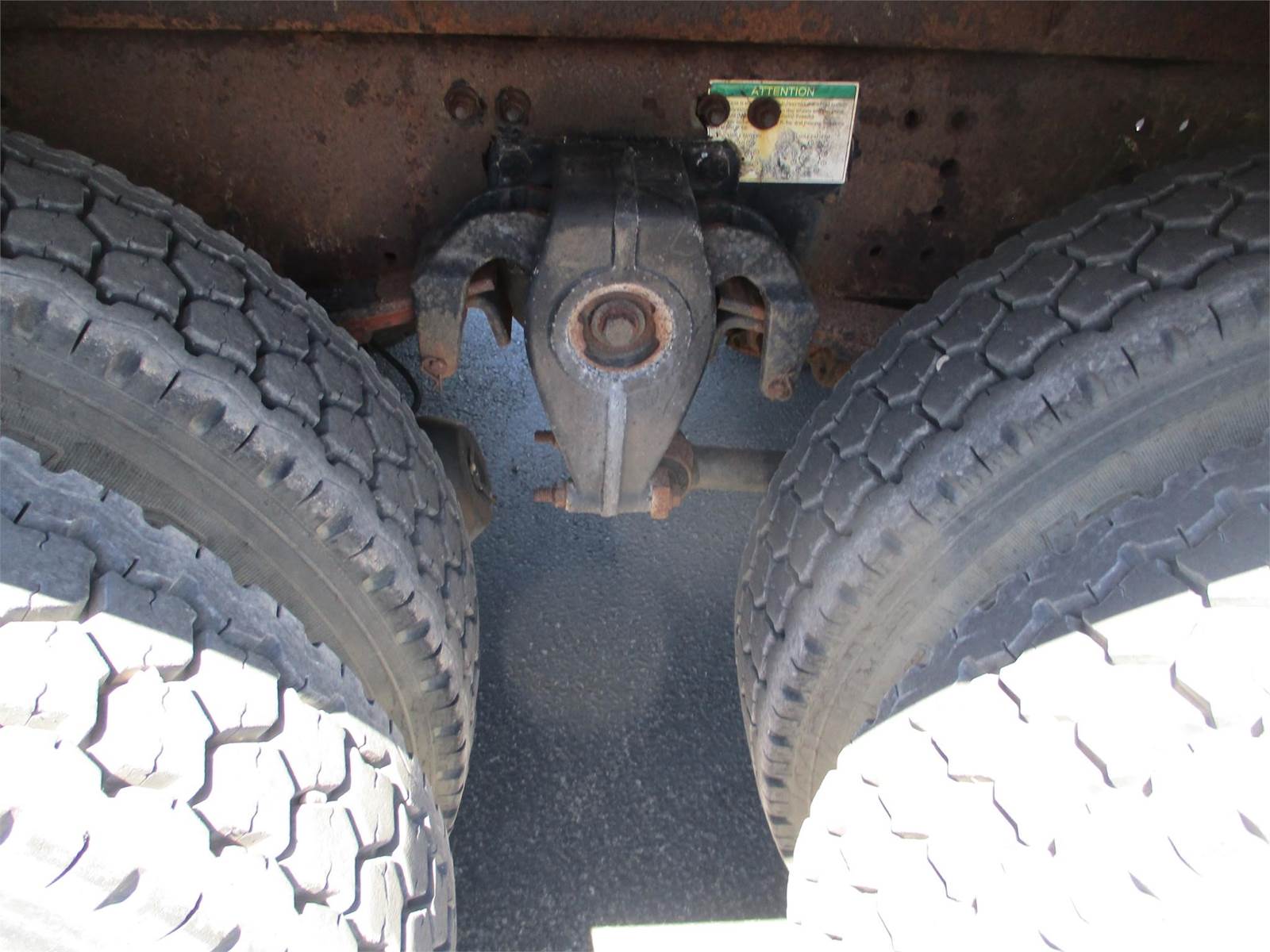 Spring Suspension in a Freightliner FL 112 Dump Truck
Spring Suspension in a Freightliner FL 112 Dump Truck
There are three different transmission options available for dump trucks—manual transmissions, automatic transmissions, or a combination of the two known as an automated manual transmission.
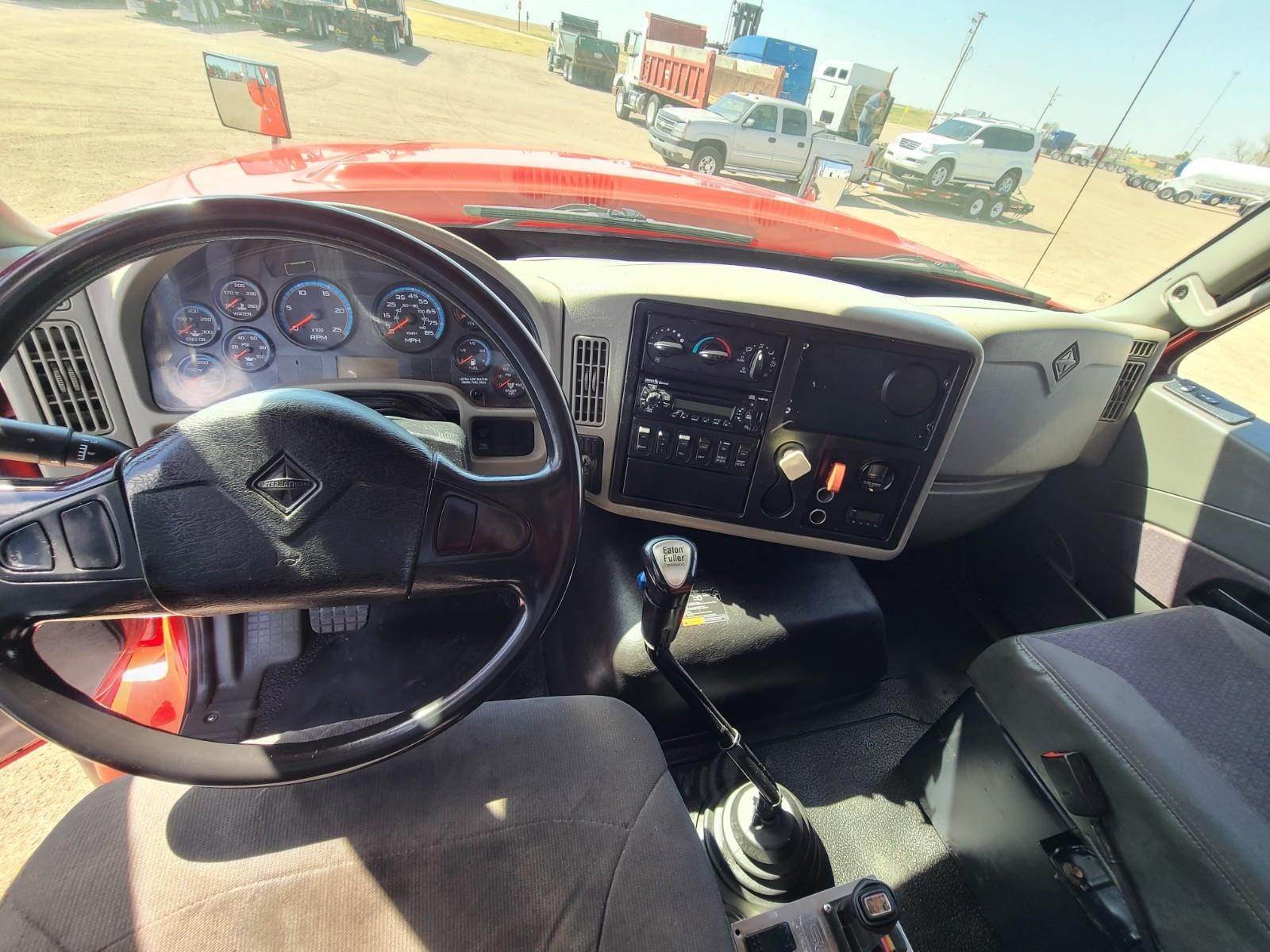 8LL manual transmission in International WorkStar 7800 Dump Truck.
8LL manual transmission in International WorkStar 7800 Dump Truck.
Manual transmissions provide the maximum fuel economy and control for experienced dump truck drivers—especially in what is referred to as 8LL transmission, which is an 8-speed manual transmission with two more deep reduction ratios for reverse or low speeds.
While manual transmissions have a list of benefits, they also require a certain level of skill on the part of the driver to operate proficiently. Driving manual transmission dump trucks for longer shifts can also be more taxing on drivers. Still, some drivers swear by their “three-pedal” trucks due to familiarity and control.
 Allison Automatic Transmission panel in a International DuraStar 4300 Dump Truck.
Allison Automatic Transmission panel in a International DuraStar 4300 Dump Truck.
Even though automatic transmissions for dump trucks may be slightly less fuel efficient and a bit more expensive—both upfront and to maintain—they’re much more common these days and the easiest for drivers to operate. This simplified performance (no gears or clutch for drivers to engage) allow for less experienced drivers or older drivers to operate their dump trucks more proficiently and with less fatigue.
Automatic transmissions are also popular for their smooth power delivery as it runs through the speeds with minimal letup—meaning minimal jostling of loads as the truck shifts. These days, most automatic transmissions in dump trucks have also replaced clutches with torque converts for enhanced gear synchronization.
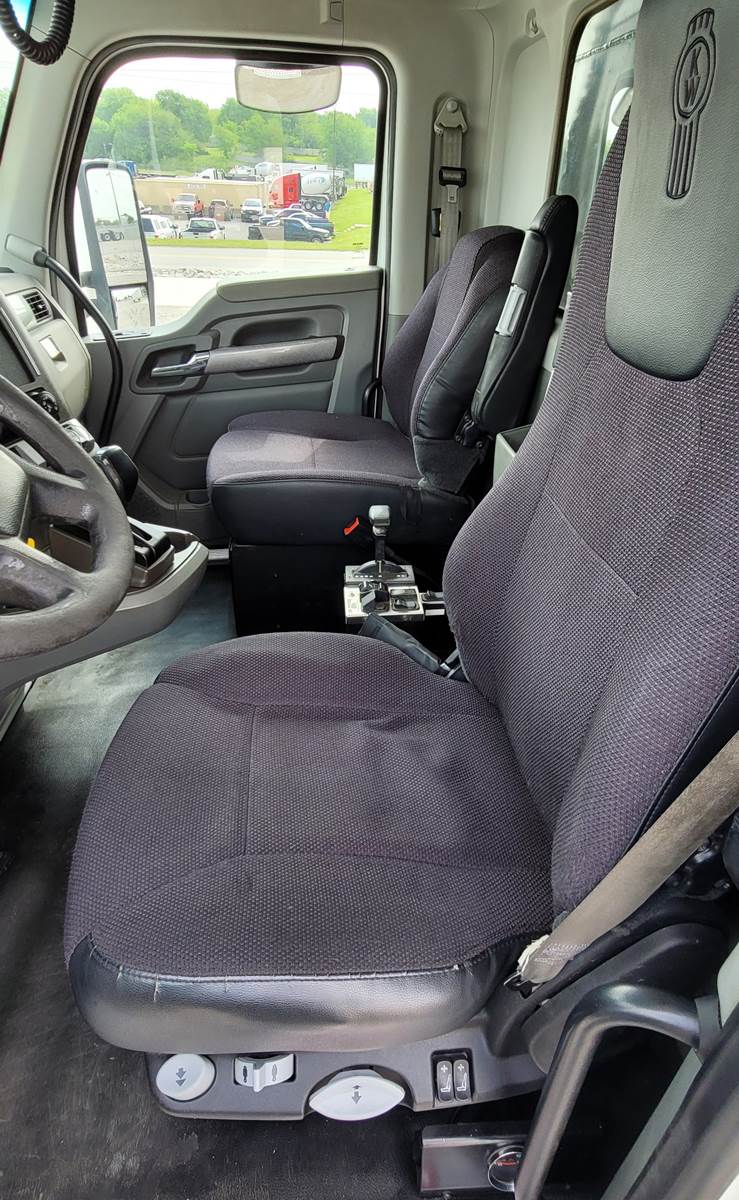 Kenworth T880 Triaxle dump truck with an 8LL automated manual transmission.
Kenworth T880 Triaxle dump truck with an 8LL automated manual transmission.
Marketed as the best of both worlds between manual and automatic transmissions, automated manual transmissions are also expressed as the worst of both worlds by some dump truck drivers. Instead of manually pressing a clutch and shifting gears, electronic sensors communicate with a computer to perform such actions when appropriate.
Though they contain similar components to a manual transmission, automated manual transmissions in dump trucks lack certain manual transmission driver functionality—such as the ability to “feather” the clutch—and other such granular controls. Also, because they’re computer controlled and therefore shift much faster than the average human shifter, automated manual transmission clutches are slightly more prone to overheating.
Though the terms are similar, there are few mechanical similarities between an automatic transmission and an automated manual transmission. A simplified expression of the difference is that an automated manual transmission functions mechanically just like a manual transmission, only that a computer has taken over the function of engaging the clutch and shifting gears instead of a human driver—as though someone installed a robot to manually shift the truck. An automatic transmission, on the other hand, was mechanically designed to automatically engage the most appropriate gear—utilizing torque converters instead of a clutch.
Automated manual transmissions tend to shift faster than automatic transmissions, but this faster computer-engaged clutch activation and gear shifting can put additional wear on the mechanical components.
The type of materials carried in your dump truck will largely determine what truck body types (also known as “boxes” by some) will serve you best. Aluminum body types are significantly lighter than resilient steel body types and will be more fuel efficient, but they are really only appropriate for hauling more malleable, lighter materials such as fill dirt, sand, and the like. Steel bodies are a better option for the ability to haul the heaviest, hardest loads that would otherwise damage or overload aluminum body/box styles.
 Mack Vision CXN612 Quad Axle Dump Truck
Mack Vision CXN612 Quad Axle Dump Truck
Street-legal dump trucks come in a variety of “box” sizes—with anywhere from 10 to 23 cubic yard boxes. Unless you’re absolutely sure of the size of the loads you will need your truck to transport on a regular basis, many drivers suggest a medium-sized box—anywhere from an 18 to 20 cubic yard box or body.
The logic in selecting a medium-sized dump truck box is that most companies charge clients by the time transporting and dumping loads, not by the volume of materials in the box. Rarely will a dump truck with a medium-sized box be inadequate for a certain load. More often than not, an oversized dump truck will be inefficient for smaller loads—burning up an undue amount of fuel and being trickier to maneuver when a smaller or medium truck could have handled such a load just as well. Thus, a medium-sized dump truck fits in the “sweet spot” of efficient yet capable and manageable.
Many dump trucks are outfitted with various updated controls that take what were once exterior controls to the inside of the cab. For the convenience of the driver, it is preferred to have a dump truck with a tailgate release and automatic tarp system—both of which can be operated from within the driver’s cab. Requiring the driver to hop out to either manually release the tailgate or roll the cargo tarp back can result in operator fatigue over long shifts.
When shopping for a dump truck for sale, make sure you’re looking at models with an appropriate box wall height for your needs. Dump truck box walls can vary from nonexistent (see flatbed dump trucks) to around over 7 feet tall (or 213 cm) or even higher. Consider what kinds of loads you will be carrying and use that information to further narrow your search.
To help distribute the weight of your dump truck’s load, lift axles may be necessary. Lift axles are additional non-powered sets of wheels that can be engaged or disengaged as needed. How many axles you will need for any given load will depend on the weight carried and the laws concerning such for use on public roads.
Aside from abiding by the law to save roads from wear, lift axles can also help reduce the wear on your tires by distributing the load.
In addition to having an automatic tarp, if you will be carrying various materials, many dump truck operators recommend utilizing an asphalt tarp for the majority of the loads. The reason here for this is that, while an asphalt tarp can be used for a variety of load materials, other tarp styles—such as a sand tarp—may not be appropriate for hauling hot asphalt.
There will likely come a time when a dump truck gets stuck—many operators say such is just part of the job. However, there are components that make getting unstuck easier and without damaging the truck.
One suggestion is to have a thicker spreader bar—the bar where the truck’s load comes off the back. A thicker spreader bar will allow heavy equipment to push the truck without the risk of damaging the truck body or other components.
Another recommendation is to have adequate pull hooks on the front and rear of your dump truck. Pull hooks make it easier for other vehicles or equipment to pull your dump truck out from wherever it is stuck without damaging it—which could happen by pulling on a bumper or something else not designed to withstand the force of pulling a truck free from a muddy road or ditch.
A standard dump truck tailgate is what is found on most commercial dump trucks. These tailgates are released from the lower edges to allow materials to be dumped off of the back of the gate. These are popular due to their affordability and low maintenance performance. While widely used in trucks that haul materials such as sand, dirt, and the like, they may not be as popular for dumping bulkier material, such as demolition and landscaping debris. Such larger elements can become stuck in the upper side of the tailgate and require operator intervention.
Where standard tailgates may get jammed with materials, two-way dump truck tailgates remedy the problem by allowing for both side and bottom opening capabilities. Though popular, they may be trickier to come by because they have been made largely obsolete by high-lift tailgates.
To eliminate snagging of debris and other tailgate issues, high-lift tailgates utilize hydraulic arms on either side to lift the tailgate clear of the rear of the box for unimpeded dumping.
To function consistently, all dump truck tailgates require proper maintenance. All hinges should be properly lubricated according to the manufacturer’s instructions either bi-weekly or every week, depending on use. The hydraulic cylinder arms for high-lift gates need to be maintained for consistent function—such as one arm not lifting as well as its opposite arm. At some point, all tailgates will require repair from an experienced technician and likely a welder.
Depending on your industry, terrain, and application, there are a variety of dump truck types to choose from. Here are a handful of dump truck styles with brief descriptions.
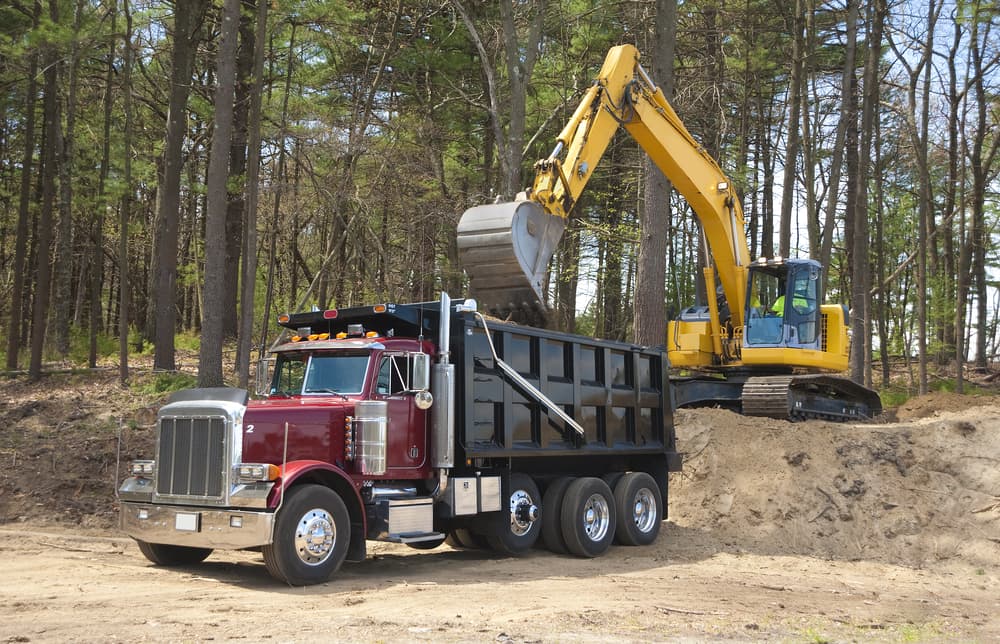
A standard dump truck is likely what you envision when you think of a dump truck—a large street-legal truck with a large dump body (also known as a “box”) that sits above permanently attached rear axles. These dump trucks can raise and lower their dump box using hydraulics to dump out of the contents in designated areas through a tailgate.

Coming in all different sizes for various applications are flatbed dump trucks. Flatbed dump trucks can be as simple as a flatbed work truck with the ability to tilt the back for dumping smaller loads, such as landscaping materials, or larger models for offloading larger cargo, such as construction equipment, materials, and the like. Some flatbed dump trucks are manufactured as such while others are preexisting work trucks with an added dumping flatbed.

Having a dump trailer at the ready for landscaping work is great but can be cost prohibitive for some. For this reason, some landscapers may opt for a landscaping truck with dumping capabilities. Landscaping dump trucks tend to be a bit smaller than larger commercial dump trucks with higher box walls than the average pickup truck bed for containing landscaping materials.

Instead of dumping out of the back of the truck, semi-trailer bottom dump trucks, also known as “belly dump” trucks, utilizes a 3-axle semi-truck combined with a 2-axle trailer equipped with a bottom-mounted dump gate also known as a “clamshell” type gate. These dump trucks are especially useful for dumping materials in a spreading motion in a line, such as within a windrow agricultural setting.
Frequently, these options are more prevalent on dump trailers—which may be a preferable alternative to a dedicated dump truck, depending on the specifications of the project.
Just like it sounds, side dump trucks—or “SDTs,” are actually semi-trucks towing 2-axle trailers with hydraulics lifts that tilt the entire box off to the side (right or left sides) rather than off the back or directly below. These dump trucks as especially good for fast dumping, as they essentially have a dump gate the length of the trailer.

Roll-off dump trucks are designed to carry removable cargo containers, such as dumpsters, storage containers, and the like. They are able to “roll off” of the containers by carefully tilting the containers with hydraulic components and a cable wench system. Roll-off dump trucks are great for being able to leave empty containers at various sites, allowing the containers to be filled while the truck is utilized elsewhere, and then the containers are picked up at a later time.

Unlike street-legal dump trucks used for hauling everything from demolition debris, rock, sand, or asphalt, off-highway dump trucks (also known as “haul trucks”) are the massive all-terrain dump trucks used for mining, quarry work, or heavier earth-moving jobs.

Somewhat like the off-highway haul trucks, articulated hauler trucks are all-wheel-drive oversized dump trucks with an articulated hauling trailer. Articulated haulers are especially good for removing loads from areas with difficult terrain.
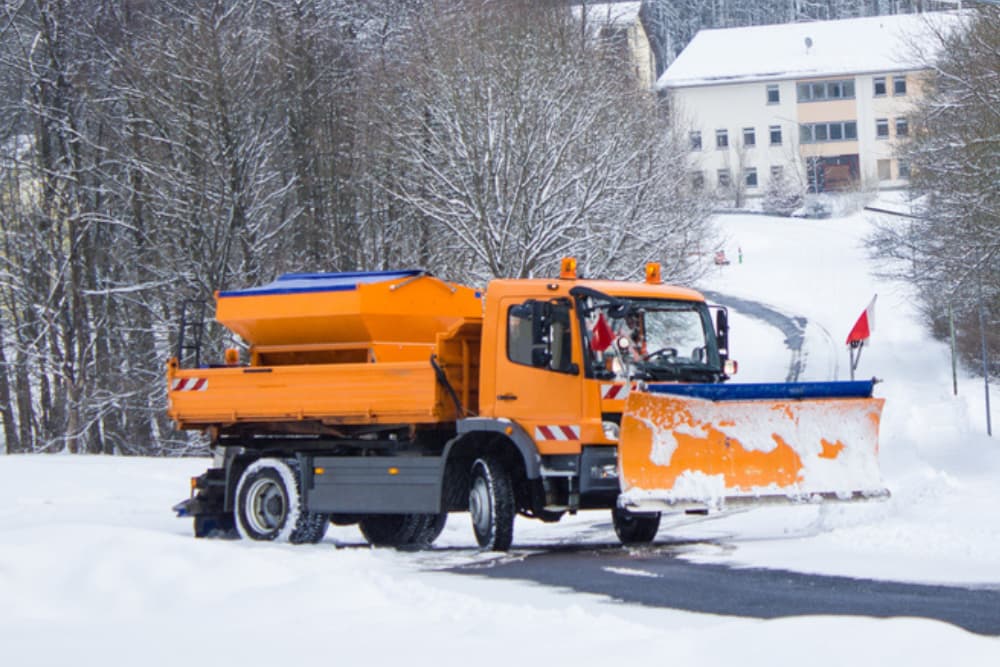
Dump trucks are frequently utilized by municipalities for winter road treatment—such as plowing or as salt spreader trucks. These dump trucks are outfitted with snow plows and ice-melt hoppers that even distribute a variety of materials to melt ice and provide traction across slick surfaces.
Even if you have narrowed down precisely which components you would like in your next dump truck you’d like to purchase, deciding whether to buy a new or a used dump truck largely depends on two factors: your budget and your need for customization.
The cost of a dump truck largely depends on the age, condition, and current market conditions. While you may be able to pick up a well-used dump truck for as low as $8,000, you can also pick up a new dump truck with a warranty for $180,000.
Your budget won’t only depend on what kind of financing you are able to procure, but also how much you plan to budget for maintenance, repairs, and downtime for such. Any time a dump truck is not working, it goes from making money to costing money. For this reason, some dump truck owners opt to pay higher prices for newer, more reliable dump truck models with warranties in order to avoid costly repairs and downtime.
Dump Truck vs. Dump Trailer: A Few Considerations
"So, when is a dump trailer a smarter option over a dump truck?"
Some construction and hauling professionals in the dump truck business may recommend looking at affordable dump trailers if you're on the fence about a dump truck. There are pros and cons to opting for dump trailers versus dump trucks, however, so it's essential to do your research.
If you plan to use your dump truck for very specialized work, you will need a specialized truck. Used models with highly specialized functionality are available, though they can be trickier to locate. For this reason, many dump truck owners with highly specific needs may opt for new dump trucks—which can be modified and customized much easier and reliably, as such parts and components are readily available from the manufacturer or existing third-party outfitters.
Find Your Next Dump Truck Today
By now, you likely have a good understanding of what kind of dump truck will best suit your needs. To help you locate the right dump truck for sale for the right price, My Little Salesman is here to help. You’re invited to look through our selection of over 1,000 dump trucks for sale to find the next addition to your fleet.
Shop For Quality New & Used Dump Trucks Now